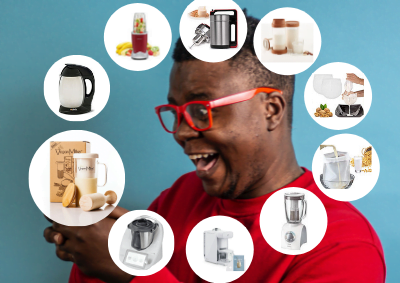
You are often asked what is the difference between making plant-based milk with the Vegan Milker (by Chufamix), or with any other tool.
In order to clarify doubts, a few years ago we carried out a very detailed comparative research. We analysed all the plant milk makers (machines, filters and tools) available on the market.
Lately, new proposals have emerged and we have analysed them in order to offer you the most updated view.
Chufamix SL is a small company that cannot invest much in advertising. So how is it possible to be a sales leader?
Vegan Milker® has been the best-selling and best-rated plant-based milk maker in Europe for 5 years (anyone can verify it on the net).
 Vegan Milker’s key to success
Vegan Milker’s key to success
We are also the only company that manufactures our tool in Europe with European and North American origin materials. All our competitors without exception manufacture their appliances in China.
All our competitors are also huge companies. Some of them are managed by investment funds and invest millions in marketing.
So how is it possible to Vegan Milker to be the market leader in Europe?
Unbeatable simplicity, versatility and emulsion.
Vegan Milker® is the only alternative on the market that has been granted a patent as an invention because its unique and radically different centrifugal emulsion system.
In all the existing systems we will discuss below, firstly the seed is grounded with water. And in some of the alternatives, there is it is also filtered.

In the case of Vegan Milker® (in combination with any domestic hand blender), we are crushing and filtering at the same time, generating a unique emulsion process which is then accompanied by a pressing process of the pulp with its pestle and mortar.
The blades of the hand blender move up and down the Vegan Milker® filter. This mobility optimises the grinding process and also generates the continuous centrifugal emulsion necessary to extract the essence of any seed, no matter how small, creating creamier and more concentrated vegetable beverages.
To verify this, now that whole (not peeled) hemp seed milk is so fashionable, being a small and difficult to grind seed, we encourage or challenge anyone to make a hemp seed milk with Vegan Milker® or any of its competitors using the same grammage and the same processing time.
Simply and objectively, there is no colour.
However, out of respect for you, we will put aside our affection for our invention, at least while we write this particular article. We will analyse the different alternatives one by one in order to show in detail their virtues, defects and differences with Vegan Milker.
Differences between the tools for making plant-based milks:
Let´s comment them one by one !
1- ‘Nutmilk bag’ or ‘Cheescloth’
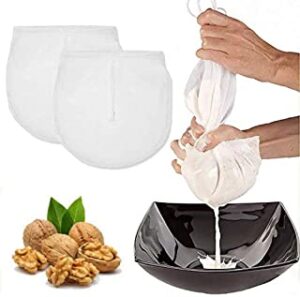
Let’s start with the basics. The nutbag or cheesecloth is the simplest tool for making plant milks. It has been used for millennia as a way of straining or filtering plant milks in all cultures around the world.
There are made with cotton, hemp or nylon (the last version we strongly advise against, especially if you are going to use hot water to make the milk).
All the nutbags currently on the market are made in China, although in many cases the companies that sell them carefully hide their origin.
The differences between this system and Vegan Milker® are:
1- Grinding & filtering efficiency: With the “nutmilk bag” or “cheesecloth” system, before straining or filtering, the seeds must be ground with water. This can be done using anything from a hand blender to a complex food processor. Once the seeds have been crushed with water, the mixture is filtered through a nutbag.
At Vegan Milker these two steps are done at the same time. With the help of a hand blender, the plant milk is crushed and filtered in one step. To finish the task, the pulp is pressed with a mortar, which allows you to squeeze out the last drops trapped in the pulp.
2- Emulsion: The fact of grinding and filtering at the same time creates a centrifugal force that makes the best “emulsion” system. SoVegan Milker® allows you to optimise the emulsification system in a way that no other system can.
3- Processing Time: Squeezing with a nutmilk bag requires time and patience. If you have both, great. Before inventing the Vegan Milker®, we have been using the bag successfully for years and were so happy. However, with Vegan Milker® we reduce the processing time to 5 minutes (including the cleaning), making the task more easy, quick and motivating.
4- Versatility with a seeds variety and other natural flavour enhancers: The nutmilk bag can be used to prepare plant-based milks with any seed except small, hard seeds such as hemp, where things get complicated. In addition, when the resulting milk is thick or dense, or has been made with hot water, straining by hand becomes complicated and can take log. This is the case of the oat milk, flax milk or other grains and nuts. With Vegan Milker®, any plant milk is ready in a “heartbeat”, regardless of whether its texture is thick, light or creamy, because you don’t need to touch the milk by hand to filter it.
5- Cleaning: The Nutmilk bag or Cheesecloth is relatively easy to clean, just like any linen or cotton cloth, but after regular using and washing, they end up breaking. On the other hand, the Nutmilk bag must be dried thoroughly to prevent fungus growing on it. The Vegan Milker® filter, being made of stainless steel, dries faster and can be cleaned in just one minute under running water. In addition, Vegan Milker® is designed to last you a lifetime if you use it correctly and we give you a two-year guarantee. Although if you detect a manufacturing defect once the guarantee has expired, please contact us at [email protected] and we will replace the spare part.
6- Other systems in this category: Nowadays have emerged some other options for filtering plant milk, such as the CHEFN filter or the BESTONZON A9. These are apparently cheap options but not optimal, as there are milks which, due to their texture, would never be filtered well by these filters. Why? Becouse they have not an effective external pressure force. They dispense with any tool for pressing the pulp.
Conclusion: The ancient “Cheesecloth” system works excellently and we recommend it to everyone. However, Vegan Milker is “the cheesecloth of the 21st century“: It’s just as simple and basic but improves emulsion, processing time and filtration quality. It is more versatile than the Nutmilk bag and allows you to make the milk without touching the food with your hands. You only have to try both systems to understand the differences.
2- “Veggie Drinks Maker” by LÉKUÉ

“Veggie Drinks Maker” is the original name we gave to our invention “Chufamix® Veggie Drinks Maker” (today known as “Vegan Milker®”) and which LÉKUÉ has had no qualms about using, despite the fact that the first and only company to use this set of words internationally from 2012 to 2018 has been Chufamix S. L. And despite the fact that we wrote them several letters asking them, please, not to confuse people, letters to which LÉKUÉ never deigned to reply.
Leaving this issue aside, LÉKUÉ is a very attractive proposal in which they have adapted the typical “French press” for making tea or coffee “Bodum®” style for plant milk’s production. Being 15 euros cheaper than Vegan Milker® and with the backing of such a prestigious brand as Lékué, we should have been wiped off the market by now, but we are still market leaders. Why?
Because the LÉKUÉ tool does not even come close to meeting customer expectations. We explain below all the details that lead us to make such a categorical statement, leaving aside our natural disagreement with LÉKUÉ’s lack of creativity when it comes to finding a name for its plant milk maker:
The differences between this system and the Vegan Milker are:
1- Patent as an invention: By building its invention on a pre-existing system (the “French” BODUM® type press), LÉKUÉ does not offer any novelty or functional advantage that is patentable over existing alternatives on the market.

2- Grinding & filtering efficiency: The Lékué preparation process is divided in two parts. First, the seed is ground with water using a hand blender and, once is ground, it is strained. To strain the milk, Lékué uses a strainer-press that is pushed to the bottom of the container, just like the system used in Bodum coffee machines. Unfortunately, the holes in the strainer-press are very micron-sized, which means that the filtering is very poor, as the remains of the seeds pass into the milk. The pulp remains are so large that it is necessary to strain the milk again with a smaller strainer that you have at home in order to avoid pulp or little seed parts into the milk.
On the other hand, at least in the version that is still marketed nowadays, part of the pulp also passes into the drink through the small spaces that remain between the sides of the press and the container when pressed.
3- Emulsion: The centrifugal emulsion allowed by the LÉKUÉ tool is minimal, as it first crushes and then filters.
4- Preparation time: The preparation time is similar to that of Vegan Milker®, but the result is not good because of what we have mentioned in the previous points.
5- Versatility with a variety of seeds: The Lékué filter-press does not reach the bottom of the container. For this reason, it is not suitable for making milk from small seeds (for example, it cannot press 50 grams of oats or 100 grams of rice, 100 grams of hemp or canaryseed, etc.). Its use is reserved for large seeds such as nuts and tiger nuts, and in addition, it forces you to use at least 100 grams of big nuts if you want to be able to press the pulp properly. So the option of freely choosing the type and quantity of seed you want to use to make the milk disappears. With Vegan Milker® this is not a problem, as it allows you to play with all type of seed and quantities as you wish.
6- Cleaning: Like the Vegan Milker, the Lékué tool is easy to clean, except for the filter-press, which has two small holes at the bottom where inevitably accumulates pulp and you have to insist on cleaning them properly.
7- Other systems in this category: we do not know of any other tool that follows this production system, although as they do not have a patent, it is likely that other big brands will copy them if the world of DIY homemade plant milk continues to conquer hearts.
Conclusion: Lékué’s Veggie Drinks Maker has some improvements to make before it becomes effective. For the moment, it is not suitable for making milk from cereals or small seeds. To make nut milk, following the instructions on the tool, you have to use 100 grams for 600 ml of milk. In short, a tool that at first glance seems cheap, turns out to be very expensive!
3- Electric machines for making plant-based milk:
We will find multiple brands of electric machines specialised in making plant milk that make it modestly. All of them have a similar design and price, are manufactured in China and can be customised with your logo for any company willing to buy a minimum of 2000 units.
We have separated the machines into two groups: ‘Thermo’ and ‘Nexpresso’ type machines, to better understand the nuances of each.
3.1- “Thermo” type machines : Soyabella, Vegan Star, Almond Cow, Soya electric, etc.
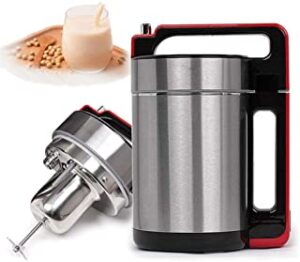
1- Grinding & filtering efficiency: As you can see in the Soyabella or Almond Cow demo-videos, the machine has fixed propeller-shaped blades which grind the seeds that are placed in the filter. The filter is placed in a container of water and the process runs when the start button is pressed.
These machines do not have an integrated pulp pressing system, which means that all the beverage that remains concentrated in the pulp is wasted. Both the Nutmilk bag and the Vegan Milker® allow the pulp to be well pressed to obtain all the essence trapped in the pulp.
In the other hand, Vegan Milker® or the Nutmilk bag are much more efficient as they allow top blending alternatives. However, these programmable machines with fixed blades are not as effective for crushing small seeds.
2- Preparation time: Depending on the programme chosen for each type of drink, the cooking time takes from 5 to 20 minutes. If we compare it with the 1-3 minutes maximum that a hand blender needs in combination with Vegan Milker®, this type of machine requires much more cooking time.
3- Emulsion: In the specific case of plant milks made from large seeds, these machines do provide a good emulsifying capacity. However, the filtering surface of the Vegan Milker® is 5 times larger which, with the fact that the hand blender mobility, it significantly increases the emulsifying capacity of the Vegan Milker® compared to these machines.
4- Versatility with a seeds variety: Unlike the Vegan Milker®, which is created to making plant milks from any seed, these machines are limited. They are designed to grind large seeds such as soy or nuts, but are not as efficient with small seeds such as quinoa, sesame, hemp, etc. Although some of them have programmes for small seeds, they are special programs that first cook the seed and then grind it, which greatly increases energy consumption and preparation time.
5- Visibility of the process: With the hand blender in Vegan Milker® or a jar blender and Nutmilk bad, you can see the whole process of making plant milk because the containers are transparent. In these machines, however, you do not see anything of what is going on inside the machine.
6- Energy consumption: These machines have programs to heat, cook and boil the milk. Some of them even require you to make the plant milk while boiling it. To do this, they have electric plates whose consumption far exceeds that of the hand blender used with the Vegan Milker or the Cheesecloth.
7- Other systems in this category: This category of machine is the one that offers the most models or brands. All brands are made in China and most of them are of dubious quality. Some of them also incorporate the possibility of making hot soups and vegetable creams: IKHOS, DAETING, MAXXO SOYAMAKER A10, BB VEGETAL C3, VEGAN REVOLUTION E5, IDAVEE E6, VEGAN STAR, etc.
Conclusion:
In this particular comparison, Vegan Milker by Chufamix brings simplicity, efficiency and greater versatility.
3.2- ‘Nexpresso’ type machines : Springlane (MILA), or the recently launched ‘Vegan Milk Maker’ (by CREATE)
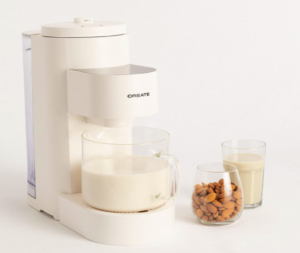
This recent version of the vegan milk maker has caught our attention. They are the most expensive machines in this category that show a very attractive design, in the Nespresso® style. The report we present is based on samples obtained with the Vegan Milk Maker (Create).
1- Grinding & filtering efficiency: It has a filterless grind chamber with a very powerful blade. The grinding tank is closed with an airtight lid that has a steam valve on the top. Once the mixture has been cooked and ground, the milk is ejected into the jar. The seed is crushed with the help of hot water in the crushing tank until it disappears. No pulp remains. There is no filtering or pressing system. As there is no filtering, the seed tiny particles remain in the milk and can be unpleasant to the palate. This is very evident with almond and soya milk. If we look for a well filtered smooth milk, we have to strain the milk again using an additional system of our own.
To better understand, let’s say that the seed is micro-crushed into the drink, which makes the resulting texture more than dense, pasty and with a lot of aftertaste, so much so that you can chew the nut particles. The filtering is therefore very poor.
Create’ provides a system that works well for making flaked or cooked grain milk and creams, but it is very poor for a plant milk made from nuts, small raw grains or tigernut milk.
2- Emulsion: The blades are very powerful. Using very hot water, they crush the seed perfectly. The blending process starts gently and increases in power until the seed is disintegrated. When the milk is ejected into the jar it falls with force and breaks up in the jar showing a frothy and well emulsified texture. However, we were disappointed when we tasted it and felt the aftertaste of the seed in our mouths.
3- Capacity: Although it shows options from 0.4 L to 1.5 L. The ideal volume of the machine is with 0.6 L, which is the capacity of the crushing tank. If we want to make more, it will first serve us the 0.6 L of drink, and then it will fill the jar with plane hot water until it reaches the volume we want to obtain.

The quantity of seeds is also very limited and ranges from a minimum of 30 g to a maximum of 80 g. Putting more seeds can cause accidents such as spillage of hot water or clogging of the channels with its consequent emergency beep to empty the tank. The photo with a full tank is false: if we fill the tank as shown in the picture, we will have a spillage accident for sure!
4- Versatility: Not very versatile in terms of preparation time and seed format to be used. It does not accept small raw seeds, nor room temperature water in the preparation process. The programs are pre-designed for certain quantities of water and seeds. If the quantity is increased or decreased, the experience can be a disaster, generating water spills or blockages in the program.
On the other hand, always grind with very hot water, there is no option to prepare plant milk with natural water. Be careful because hot water is interesting to use to prepare grain or soy milk, however, its use is discouraged in nut milks and small seeds as these seeds are sensitive to heat and deteriorate quickly if cooked. Also with some seeds, the hot water activates the fiber which turns the drink into a mushy puree.
5- Processing time (for 0.6L): Minimum 17 minutes processing time for each drink + 5 minutes automatic cleaning + 5 minutes automatic drying = 27 minutes.
6- Cleaning: The milk jar, the water tank, the lid of the blender tank and the lower support grid are cleaned by hand. However, the internal part of the machine, the grinder tank and ejection channel, must be cleaned with the automatic cleaning and drying program, which takes 10 minutes and uses hot water.
7- Energy consumption: This is an exorbitant energy consumption compared to the energy used with a simpler system such as a Vegan Milker or a Nutmilk Bag. Whatever milk we want to make, it forces us to boil the water and use the high-powered grinder. This is an exaggerated consumption to produce 0.6 L of plant milk. In addition to the production process, the machine requires more energy for cleaning. The program reheats the water and moves the grinder for the final cleaning and drying of the internal tank.
8- Visibility: it is not possible to observe the grinding process as everything happens in a hidden space.
Conclusion:
The machines described here are between 3, 4 and up to 6 times more expensive than Vegan Milker. Aesthetically they may look attractive, however, functionally they are light years away from the simplicity, speed, efficiency and versatility for any seed that the Vegan Milker® provides.
4- OTHER INTERESTING MACHINES and ROBOTS:
We will now briefly describe the synergies that arise with other more general options. They are machines that can be used to make everything, which may confuse us thinking that they can also be used to make plant milks. We will summarize what each of them can contribute when we want to prepare plant-based milk at home.
 4.1. Thermomix
4.1. Thermomix
The Thermomix is an excellent food processor but does not filter or emulsify seeds.
However, you can grind the hardest seeds like tiger nuts, hazelnuts, almonds e.t.c … in a few seconds. After grinding, put them in the Chufamix, and make your plant milk without having to soak the seeds overnight.
Conclusion: Thermomix and Chufamix offer a 100% complementary technical partnership .
4.2. Vitamix
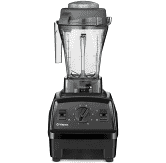
We are fans of the Vitamix. Made in USA, it is the “Rolls Royce” of machines for making “smoothies” and plant milks.
The Vitamix isn´t as programmable as the Thermomix, but it has a filtering function included.
However, the process of making plant milk and subsequent cleaning of the machine is significantly more complex than that of the Vegan Milker.
Neither machine can be used to press the pulp as we do using the Vegan Milker.
However, as with Thermomix, harder seeds can be ground using the Vitamix and then used in the Vegan Milker to avoid having to presoak.
Conclusion: As an expert in Biofach (Germany), who has the Vitamix told us :
“The Vitamix is the Rolls Royce but Vegan Milker … is the wheel ! “
4.3. Nutribullet or Magicbullet

As advertised on TV, the Nutribullet, Magicbullet, may work well with some fruits and vegetables, but NOT with nuts and other seeds.
The Nutribullet´s accessory named “filter” does not fit tightly to the machine so the pulp escapes between the lower blades.
The result is a lumpy and undrinkable plant milk.
In addition: i) the amount of milk that can be made is minimal. ii) the appliance can be damaged depending on what seed is used (and getting it covered under warranty is difficult) iii) it does not work correctly with many small seeds.
Conclusion: We advise against buying these machines for making plant milks.
4.4. Blender with “filter” accessory

Some “table blenders” have an accessory filter that is adjustable to the blades. They work great with vegetables and fruits, and better than the Nutribullet with nuts and other seeds.
However, the filter attachment does not fit tightly enough and some pulp passes through into the plant milk, so the resulting texture is not great.
Using seeds in the filter makes the machine difficult to assemble because you have to try and put it together without the seeds falling out. Also taking it apart once the milk is processed is quite difficult. In addition, the pulp is trapped in the filter and it´s impossible to squeeze it entirely.
Conclusion: If you want to make plant milks, and other creams and juices, buy a powerful hand mixer with all accessories and the Vegan Milker. You’ll thank us!!
4.5. Slowjuicers

The Slowjuicers are specialized machines for processing fruits and vegetables.
We know that some are also capable of processing seeds and nuts, while many others are not.
For now, we only have seen how one of the most prestigious and expensive machines work: the “Kuvings”.
First thing to note is that the grinding or blending system is by cold pressing, not blending.
The result with vegetables and fruits is excellent, but when using seeds and nuts, here is what we´ve found:
1-Emulsion efficiency is minimal. The official cookbook of the Kuvings recommends using 150 grams of soy to produce 200 ml of soy milk, or 180 grams of almonds to make 250 ml (cup) of almond milk.
With the same amount of seeds, Vegan Milker can produce 0,8 liter of creamy almond milk, and at least 1.5 liters of soy milk.
2-It is not able to correctly process small seeds because the pressing system is designed for fruits and vegetables, not for small seeds.
3-The leftover pulp is extremely wet and retains much of the nutrients of the seed or nut that should be left in the milk and not in the pulp.
Conclusion: If you buy it to make vegan milks, make sure that it allows you to process any type of seeds correctly and efficiently .
4.6. Grinding seeds without filtering
There have been several times that people have asked us “why is it necessary to filter the vegan milk?”. They think that the “filter” is useless.
Some people think that if you can eat a walnut or an almond, you can also blend them directly with water to obtain a tasty vegan milk.
Well, then millions of people for thousands of years have wasted their time in filtering vegan milks. Maybe it was just for fun?!
Conclusion: Beat with hand mixer or blender 150 grams of walnuts, 1 liter of water and sweetener to taste (optional). Try this “crunchy milk”, and if you like it, great!!! … you don´t need a Vegan Milker!
FINAL CONCLUSION
With the peace of mind that comes from having good advice, we state that:
Today there is no system as SIMPLE, fast and efficient as the Vegan Milker to make vegan milk or plant-based milk.
We hope this article has shed some light on your quest for the best system.
However, we believe the best thing is to experiment yourself with people who already have these machines and tools at home.
Nothing beats trying it out yourself!

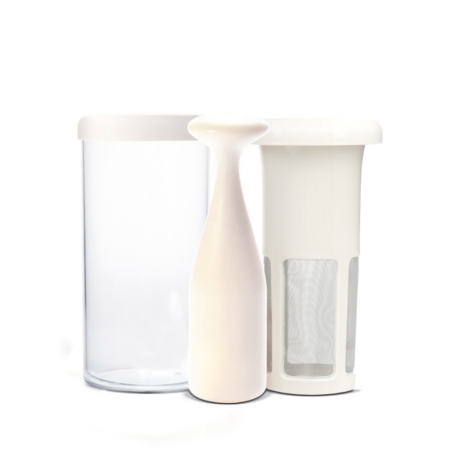
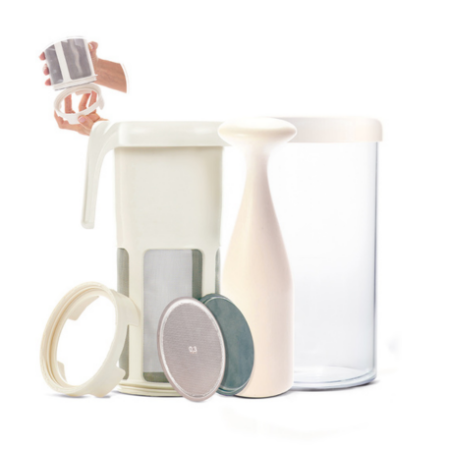
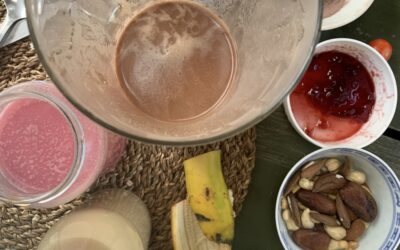
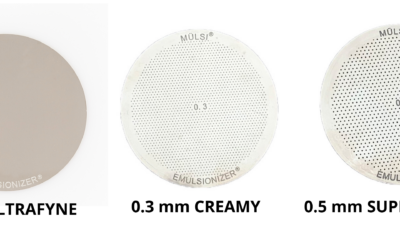

0 Comments